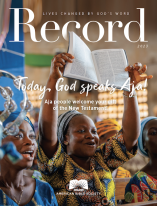Discover the Very Good Gospel and God’s Healing in the World
Discussion Guide: The Very Good Gospel, by Lisa Sharon Harper
In The Very Good Gospel: How Everything Wrong Can Be Made Right, (New York: Waterbrook, 2016) Lisa Sharon Harper fantastically crafts an introduction to the gospel that incorporates aspects of God’s healing in this world, a work emerging from her desire to be a faith-centered advocate for social justice. She guides readers through the narrative of the “good” creation, the destruction of the Fall, and the “good” story of the gospel of reconciliation in our world today.
Harper frames the book in the biblical concept of shalom: how God’s wholeness serves as the basis to heal ourselves, our communities, and our world. Through this lens of wholeness, Harper invites us to envision a gospel that introduces others to God’s work of peace bringing healing to our fractured world. Environmental stewardship, female and male relationships, nations, families, and our sense of self are just a few of the areas through which Harper helps us see the gospel transforming our world today.
As a theology professor, I have also seen this book transform my classrooms. As students engage with these concepts, their understanding of the gospel is bolstered and their call to partner in God’s work of shalom solidified. I offer you the following discussion guide to implement in a reading group in your churches. Give some leeway to purchase and read the book, then gather together to discuss with these prompts.
Did you ever have an awakening in your faith where you realized your understanding of the gospel was incomplete? Describe your experience.
Harper encountered a transformation in her own faith when she realized “the good news of my gospel doesn’t feel good enough” (2). Much of this journey for her came from a realization of how often people who claimed to follow Christ were still complicit in racial sins and discrimination. She identified that the Scriptures speak to individual reconciliation with God, self and neighbor, but that the message of the gospel also emphasizes freedom for the oppressed and systemic justice. “If one’s gospel falls mute when facing people who need good news the most—the impoverished, the oppressed, and the broken—then it’s no gospel at all” (14). Have you noticed ways in which our understanding of the gospel fails the people who need the good news the most?
How have you seen a “thin” faith creep into your own life? How have you worked to develop a “thick” faith?
“Thin” faith, Harper proposes, simplifies the gospel to a surface reading of the Scriptures and to applying verses out of context. “Thin” faith also copies the words of others without deep contextual study and without the teachings of church mothers and fathers. “For more than a century now, thinned out faith has left the divided American church struggling to grasp the significances of the prophetic voices among us” (11). How have you seen this in our politicians, our athletes, and our celebrities? And which Christians today model a “thick” faith?
How do you understand the concept of shalom?
As Harper reminds us, the Hebrew term shalom is used 550 times in the Scriptures. Its definition often gets simplified to “peace,” but she encourages us to consider other meanings that extend to wholeness, restoration, loyal devotion, and an offering of peace. God’s peace implies wholeness, complete well-being and abundance, echoing the perfection of creation. Matthew 5:9 in the Beatitudes calls the “shalom doers” blessed. How do you see some of these definitions of shalom in your own community? What areas in your neighborhood need greater shalom? What areas in your own life need greater shalom?
In our racially divided world, what insights did Harper give you about shalom and race?
As a black woman, Harper experienced racial brokenness in her own life and community. She shares her personal story of God’s shalom and racial reconciliation, which motivated her engagement in faith communities after Ferguson, MO. Harper uses the biblical creation account to frame that conversation: “God created humanity in God’s own image, in the divine image God created them…” (Genesis 1:27, CEB). This promise entrusts humanity to protect God’s image in one another. One way to do this is through restoring one another’s agency.
She points out that we often limit other’s agency in not considering that communities of color can, and must, and already are, leaders in the church. Isaiah 61:1-15 says the good news to the oppressed is that “…they shall repair the ruined cities, the devastations of many generations.” Harper invites us to see how the oppressed or overlooked neighborhoods in our communities are doing the difficult work of shalom, creating spaces where God is in turn teaching the whole church. Do we see those who are oppressed in our neighborhoods as the leaders and the teachers? What can we learn from them?
If the gospel is good news, and as Harper reminds us, very good news, let us continue to be a people who let that very good news permeate every part of our lives.

Jennifer M. Buck
Jennifer M. Buck is an Assistant Professor of Practical Theology at Azusa Pacific University. She holds a PhD in Philosophy of Religion and Theology from Claremont Graduate University and an MDiv from Fuller Theology Seminary. She is a licensed minister in the Evangelical Friends church and served for 8 years on pastoral staff. She is the author of Reframing the House: Constructive Feminist Global Ecclesiology for the Western Evangelical Church (Pickwick, 2016).
Thanks to the support of our faithful financial partners, American Bible Society has been engaging people with the life-changing message of God’s Word for more than 200 years.
Help us share God's Word where needed most.
Connect with our Bible engagement blog for leaders and receive a Bible-reading Habit Guide for your community.









